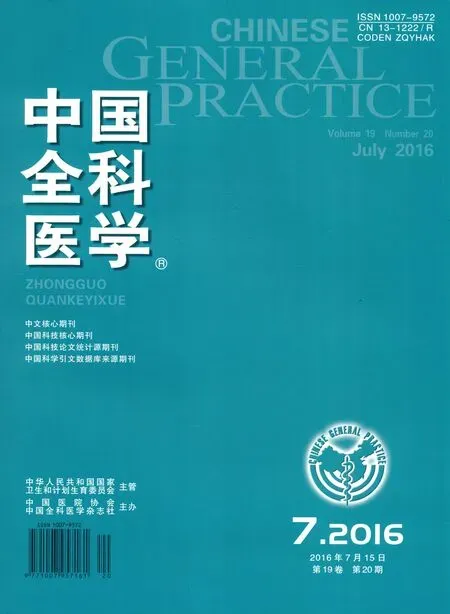術前及術后貧血對肺大細胞神經內分泌癌患者預后的影響
王 巖,周 軍,戴素麗,許西娥,陶仁海,劉俊峰
?
·論著·
術前及術后貧血對肺大細胞神經內分泌癌患者預后的影響
王 巖,周 軍,戴素麗,許西娥,陶仁海,劉俊峰
050011河北省石家莊市,河北醫科大學第四醫院胸外科(王巖,許西娥,劉俊峰),手術室(陶仁海);定州市武警8640部隊醫院(周軍);河北省腫瘤研究所(戴素麗)
【摘要】目的探討術前及術后貧血對肺大細胞神經內分泌癌(LCNEC)患者預后的影響。方法選取2007年7月—2013年7月于河北醫科大學第四醫院胸外科治療的LCNEC患者44例為研究對象,收集患者臨床特征資料。以手術日期為觀察起點,死亡為臨床終點事件計算生存期,隨訪至2014年8月。結果不同性別、年齡、吸煙史、腫瘤直徑、病理類型、TNM分期、手術方式以及是否發生術前及術后貧血、淋巴結轉移患者生存時間比較,差異均有統計學意義(P<0.05)。Cox比例風險回歸模型分析結果顯示,年齡〔HR=6.751,95%CI(3.576,15.438)〕、吸煙史〔HR=3.438,95%CI(1.053,6.538)〕、病理類型〔HR=10.643,95%CI(6.634,21.982)〕、術前貧血〔HR=0.043,95%CI(0.027,0.051)〕、術后貧血〔HR=8.451,95%CI(4.885,9.372)〕、手術方式〔HR=2.334,95%CI(1.658,21.575)〕是LCNEC患者預后的影響因素(P<0.05)。結論術前及術后貧血與LCNEC患者預后有關。
【關鍵詞】癌,非小細胞肺;貧血;預后
王巖,周軍,戴素麗,等.術前及術后貧血對肺大細胞神經內分泌癌患者預后的影響[J].中國全科醫學,2016,19(20):2416-2419.[www.chinagp.net]
WANG Y,ZHOU J,DAI S L,et al.Impact of preoperative and postoperative anemia on the prognosis of pulmonary large cell neuroendocrine carcinoma patients[J].Chinese General Practice,2016,19(20):2416-2419.
肺大細胞神經內分泌癌(LCNEC)是非小細胞肺癌的亞型,但惡性程度高,易發生侵襲和轉移,預后較差[1],臨床治療以手術為主[2-4]。貧血是惡性腫瘤患者的常見并發癥,稱為癌性貧血,其發病率甚至高達50%以上[5-6]。有研究表明,癌性貧血與患者的生活質量、抗腫瘤治療的效果及預后密切相關[7-8]。為探討LCNEC患者發生貧血的臨床情況以及貧血與經手術治療的LCNEC患者預后的關系,本研究分析河北醫科大學第四醫院44例LCNEC患者術前及術后貧血發生情況對預后的影響。
1資料與方法
1.1臨床資料選取2007年7月—2013年7月于河北醫科大學第四醫院胸外科治療的LCNEC患者44例為研究對象,其中男40例,女4例;年齡26~76歲,平均年齡(59.5±10.2)歲;單純LCNEC 24例,LCNEC合并其他病理類型20例;TNM分期:Ⅰ期20例,Ⅱ~Ⅳ期24例;淋巴結轉移17例,支氣管切緣陽性4例,脈管瘤栓2例。患者均行手術切除腫瘤組織,行保守性切除3例,行解剖性切除41例。納入標準:(1)術后病理確診為LCNEC;(2)術前未接受放化療;(3)術前1個月內未經輸血治療。排除標準:(1)心功能、肝腎功能和骨髓造血功能異常;(2)合并慢性感染、炎癥及血液疾病。
1.2方法
1.2.1臨床資料收集收集患者性別、年齡、吸煙史、腫瘤家族史、腫瘤位置、腫瘤直徑、病理類型、TNM分期、手術方式,以及是否發生淋巴結轉移、支氣管切緣陽性、脈管瘤栓等臨床特征。分別于術前1周和術后4周抽取靜脈血2 ml,2 h內采用血細胞分析儀測定血紅蛋白(Hb)水平。以貧血的嚴重程度分為:0級(正常)為Hb≥110 g/L;Ⅰ級(輕度)為95 g/L≤Hb<110 g/L;Ⅱ級(中度)為80 g/L≤Hb<95 g/L;Ⅲ級(重度)為65 g/L≤Hb<80 g/L;Ⅳ級(極重度,危及生命)為Hb<65 g/L。
1.2.2隨訪以手術日期為觀察起點,死亡為臨床終點事件計算生存期,隨訪至2014年8月。患者隨訪時間3~27個月,無失訪患者。
1.3統計學方法采用SPSS 20.0統計軟件進行統計分析,以Kaplan-Meier法計算生存率,采用Log-rank檢驗不同臨床特征患者生存時間,采用Cox比例風險回歸模型分析患者預后的影響因素。以P<0.05為差異有統計學意義。
2結果
2.1不同臨床特征患者生存時間比較有無腫瘤家族史、支氣管切緣陽性、脈管瘤栓以及不同腫瘤位置患者生存時間比較,差異均無統計學意義(P>0.05)。不同性別、年齡、吸煙史、腫瘤直徑、病理類型、TNM分期、手術方式以及是否發生術前及術后貧血、淋巴結轉移患者生存時間比較,差異均有統計學意義(P<0.05,見表1)。
2.2Cox比例風險回歸模型分析以隨訪期內是否死亡為因變量,單因素比較差異有統計學意義的臨床特征為自變量行Cox比例風險回歸模型分析,變量賦值見表2。Cox比例風險回歸模型分析結果顯示,年齡、吸煙史、病理類型、術前和術后貧血、手術方式是LCNEC患者預后的影響因素(P<0.05,見表3)。
表1不同臨床特征患者生存時間比較
Table 1Comparison of survival time among patients with different clinical features

臨床特征例數1年生存率(%)2年生存率(%)χ2值P值性別4.2260.042 男4078.216.7 女4100.025.0年齡(歲)4.3950.032 ≤602771.815.1 >601782.621.2吸煙史5.3160.022 是4175.416.2 否384.334.5腫瘤家族史0.3360.581 有474.215.7 無4076.217.6腫瘤位置1.5160.193 中央型1571.815.4 周圍型2978.119.1腫瘤直徑(cm)8.5610.003 ≤32270.314.5 >32281.518.4病理類型4.9530.024 單純LCNEC2470.414.2 合并其他類型2082.721.3TNM分期9.1670.002 Ⅰ期2080.622.1 Ⅱ~Ⅳ期2472.113.6術前貧血4.8860.027 有1182.333.0 無3373.916.3術后貧血18.439<0.001 有3656.60 無880.325.1淋巴結轉移10.6630.001 有1772.414.2 無2778.219.4支氣管切緣1.7560.185 陽性475.314.1 陰性4076.017.8脈管瘤栓1.6030.196 有275.616.4 無4276.016.5手術方式4.5820.036 保守性切除363.712.6 解剖性切除4176.917.8
注:LCNEC=肺大細胞神經內分泌癌
表2LCNEC患者預后影響因素的Cox比例風險回歸模型賦值
Table 2Variable assignment of Cox proportional hazard regression model analysis on influencing factors for the prognosis of LCNEC patients

變量賦值性別男=1,女=0年齡(歲)≤60=1,>60=0吸煙史是=1,否=0腫瘤直徑(cm)≤3=1,>3=0病理類型單純LCNEC=1,合并其他類型=0TNM分期(期)Ⅰ=1,Ⅱ~Ⅳ=0術前貧血有=1,無=0術后貧血有=1,無=0淋巴結轉移有=1,無=0手術方式保守性切除=1,解剖性切除=0預后死亡=1,存活=0
表3LCNEC患者預后影響因素的Cox比例風險回歸模型分析
Table 3Cox proportional hazard regression model analysis on influencing factors for the prognosis of LCNEC patients

變量b標準誤Waldχ2值HR(95%CI)P值性別-0.5762.4351.5200.562(0.045,1.161)0.717年齡1.9102.9212.2756.751(3.576,15.438)0.044吸煙史1.2353.3591.2103.438(1.053,6.538)0.001腫瘤直徑0.2713.1161.7201.311(0.915,1.366)0.247病理類型2.3652.8651.20510.643(6.634,21.982)0.018TNM分期-1.1683.2671.3400.311(0.118,1.873)0.488術前貧血-3.1470.3496.5700.043(0.027,0.051)0.024術后貧血2.1340.42113.2058.451(4.885,9.372)<0.001淋巴結轉移0.7142.7532.5702.043(0.635,15.435)0.473手術方式0.8482.5301.8962.334(1.658,21.575)0.009
3討論
癌性貧血是惡性腫瘤患者尤其是晚期腫瘤患者常見并發癥之一。有研究顯示,腫瘤患者合并貧血可達53.7%[9],我國對腫瘤患者調查發現貧血發病率為60%,并以輕至中度為主[10]。研究發現老年、TNM分期較晚、體力狀態差以及近期手術或放化療與貧血發生率升高有關[11-12]。
貧血導致腫瘤細胞缺氧,引起腫瘤侵襲性增強[3-4]。研究顯示,缺氧還可促進腫瘤新生血管的生成,同時誘導多種炎性因子的表達,使腫瘤更易發生浸潤或轉移,導致腫瘤患者預后不良[5]。在本研究中,單因素及多因素分析顯示術前貧血與術后貧血是LCNEC患者預后的獨立影響因素。但由于本研究的樣本量較小,其結果仍需通過納入更多的LCNEC患者以得到進一步證實。
本研究結果發現,術前貧血是LCNEC患者預后的保護性因素,但術前存在重度貧血,經輸血治療糾正貧血的患者未納入本項研究,貧血對于該部分患者的預后影響有待進一步研究證實。根據本研究結果,對于術前檢查出的輕至中度貧血,術前可不予刻意糾正其至正常水平。
有臨床研究認為,腫瘤合并貧血是預后不良的危險因素[13-14]。HOLGERSSON等[13]研究顯示,合并貧血的非小細胞肺癌患者中位生存時間為11.2個月,而無貧血的患者中位生存時間為14.5個月,5年生存率分別為4.6%與7.6%。WAN等[14]對肺癌、結直腸癌、乳腺癌、肝癌患者預后研究發現,合并貧血的腫瘤患者與無貧血的患者相比,其生存期更短。
LCNEC發生術后貧血的患者預后較差,與其他研究結果一致[13-14]。有研究表明,晚期LCNEC患者糾正術后貧血,可提高生活質量,延長生存期[15]。因此,對于LCNEC患者術后發生的貧血,應積極尋找發生原因,并給予相應治療。有條件的患者,在術后可規律監測Hb水平,及時采取積極措施,以減少貧血的發生風險,提高LCNEC患者治療效果,改善預后。
作者貢獻:王巖負責進行課題設計與實施、資料收集整理、撰寫論文、成文并對文章負責;周軍、戴素麗、許西娥、陶仁海進行課題實施、評估、資料收集;劉俊峰進行質量控制及審校。
本文無利益沖突。
參考文獻
[1]TRAVIS W D,LINNOILA R I,TSOKOS M G,et al.Neuroendocrine tumors of the lung with proposed criteria for large-cell neuroendocrine carcinoma.An ultrastructural,immunohistochemical,and flow cytometric study of 35 cases[J].Am J Surg Pathol,1991,15(6):529-553.
[2]BATTAFARANO R J,FERNANDEZ F G,RITTER J,et al.Large cell neuroendocrine carcinoma:an aggressive form of nonsmall lung cancer[J].J Thorac Cardiovasc Surg,2005,130(1):166-172.
[3]TOMITA M,SHIMIZU T,AYABE T,et al.Preoperative neutrophil to lymphocyte ratio as a prognostic predictor after curative resection for non-small cell lung cancer[J].Anticancer Res,2011,31(9):2995-2998.
[4]TOMITA M,SHIMIZU T,AYABE T,et al.Elevated preoperative inflammatory markers based on neutrophil-to-lymphocyte ratio and C-reactive protein predict poor survival in resected non-small cell lung cancer[J].Anticancer Res,2012,32(8):3535-3538.
[5]TERAMUKAI S,KITANO T,KISHIDA Y,et al.Pretreatment neutrophil count as an independent prognostic factor in advanced non-small cell lung cancer:an analysis of Japan Multinational Trial Organisation LC00-03[J].Eur J Cancer,2009,45(11):1950-1958.
[6]MOTOMURA T,SHIRABE K,MANO Y,et al.Neutrophil-lymphocyte ratio reflects hepatocellular carcinoma recurrence after liver transplantation via inflammatory microenvironment[J].J Hepatol,2013,58(1):58-64.
[7]KANTOLA T,KLINTRUP K,VAYRYNEN J P,et al.Stage-dependent alterations of the serum cytokine pattern in colorectal carcinoma[J].Br J Cancer,2012,107(10):1729-1736.
[8]ROSSI G,CAVAZZA A,MARCHIONI A,et al.Role of chemotherapy and the receptor tyrosine kinases KIT,PDGFR-alpha,PDGFR-beta,and met in large-cell neuroendocrine carcinoma of the lung [J].J Clin Oncol,2005,23(34):8774-8785.
[9]CHEN Y,ZHANG L,LIU W X,et a1.Prognostic significance of preoperative anemia,leukocytosis and thrombocytosis in Chinese women with epithelial ovarian cancer[J].Asian Pac J Cancer Prev,2015,16(3):933-939.
[10]楊波,姜宏寧,余敏,等.貧血對老年晚期惡性腫瘤患者生命質量的影響[J].腫瘤研究與臨床,2015,27(1):32-34.
YANG B,JIANG H N,YU M,et al.Effect of anemia on quality of life in elderly patients with advanced cancer[J].Cancer Research and Clinic,2015,27(1):32-34.
[11]張思維,張敏,李光琳,等.2003~2007年中國食管癌發病與死亡分析[J].中國腫瘤,2012,21(4):241-247.
ZHANG S W,ZHANG M,LI G L,et al.An analysis of incidence and mortality of esophageal cancer in China,2003—2007[J].China Cancer,2012,21(4):241-247.
[12]孫堯,劉希軍,于甬華.食管癌精確放療的研究進展[J].中華腫瘤防治雜志,2012,19(9):712-716.
SUN Y,LIU X J,YU Y H,et al.Study of esophageal cancer accurate radiotherapy[J].Chinese Journal of Cancer Prevention and Treatment,2012,19(9):712-716.
[13]HOLGERSSON G,SANDELIN M,HOYE E,et al.Swedish lung cancer radiation study group:the prognostic value of anaemia,thrombocytosis and leukocytosis at time of diagnosis in patients with non-small cell lung cancer[J].Med Oncol,2012,29(5):3176-3182.
[14]WAN S,LAI Y,MYERS R E,et al.Post-diagnosis hemoglobin change associates with overall survival of multiple malignancies-results from a 14-year hospital-based cohort of lung,breast,cnlorectal,and liver caneers[J].BMC Cancer,2013,13:340.
[15]SARRAF K M,BELCHER E,RAEVSKY E,et al.Neutrophil/lymphocyte ratio and its association with survival after complete resection in non-small cell lung cancer[J].J Thorac Cardiovasc Surg,2009,137(2):425-428.
(本文編輯:吳立波)
Impact of Preoperative and Postoperative Anemia on the Prognosis of Pulmonary Large Cell Neuroendocrine Carcinoma Patients
WANGYan,ZHOUJun,DAISu-li,etal.
DepartmentofThoracicSurgery,theFourthHospitalofHebeiMedicalUniversity,Shijiazhuang050011,China
【Abstract】ObjectiveTo explore the influence of preoperative and postoperative anemia on the prognosis of patients with pulmonary large cell neuroendocrine carcinoma (LCNEC).MethodsFrom July 2007 to July 2013,we enrolled 44 LCNEC patients who received treatment in the Department of Thoracic Surgery of the Fourth Hospital of Hebei Medical University.Data of clinical features of the patients were collected.With the date of surgery as the start point and death as the endpoint,survival time of patients was calculated.The follow-up was conducted until August 2014.ResultsThere were significant differences in survival time among patients with different genders,ages,history of smoking,diameters of tumor,pathological types,TNM stages,surgical methods and between patients with and without preoperative and postoperative anemia,lymph node metastasis(P<0.05).Cox proportional hazard regression model analysis showed that age〔HR=6.751,95%CI(3.576,15.438)〕,history of smoking〔HR=3.438,95%CI(1.053,6.538)〕,pathological types〔HR=10.643,95%CI(6.634,21.982)〕,preoperative anemia 〔HR=0.043,95%CI(0.027,0.051)〕,postoperative anemia 〔HR=8.451,95%CI(4.885,9.372)〕 and surgical methods 〔HR=2.334,95%CI(1.658,21.575)〕 were influencing factors for the prognosis of LCNEC patients (P<0.05).ConclusionPreoperative and postoperative anemia are related with the prognosis of LCNEC patients.
【Key words】Carcinoma,non-small-cell lung;Anemia;Prognosis
通信作者:劉俊峰,050011河北省石家莊市,河北醫科大學第四醫院胸外科;E-mail:20504744@qq.com
【中圖分類號】R 730.26 R 556
【文獻標識碼】A
DOI:10.3969/j.issn.1007-9572.2016.20.011
(收稿日期:2015-10-16;修回日期:2016-05-29)

